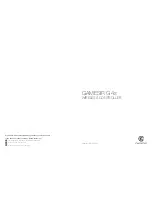
3. AIAO Units
MN05003006E F or more information visit:
w w w. e a t o n . c o m
1-43
C R # 3 0 :
Fault Register
CR#30 contains the present fault code. Refer to the following chart.
Fault description
Content
b15~b8
b7 b6 b5 b4 b3 b2 b1 b0
Power source abnormal
(Low voltage alarm)
K1(H1)
0
0 0 0 0 0
0
1
User setting D/A output
exceeds range
K2(H2)
0
0 0 0 0 0
1
0
Setting
mode
error
K4(H4)
0
0 0 0 0 1
0
0
Offset/Gain
error
K8(H8)
0
0 0 0 1 0
0
0
Hardware
malfunction
K16(H10)
0
0 0 1 0 0
0
0
Digital
range
error
K32(H20)
0
0 1 0 0 0
0
0
Average times setting error K64(H40)
0
1 0 0 0 0
0
0
Command error
K128(H80)
Reserved
1
0 0 0 0 0
0
0
Note: Each fault code will have corresponding bit (b0~b7). Two or more faults may
happen at the same time. 0 means normal and 1 means having fault.
C R # 3 1 :
RS-485 communication address setting
The RS-485 communication address. Range: 01 ~ 255. Default = K1. This setting is only
valid for RS-485 communication and will be invalid when connected to an ELC controller.
C R # 3 2 :
Communication speed (baud rate) setting
The RS-485 communication data rates: 4,800, 9,600, 19,200, 38,400, 57,600 and
115,200bps (bits per second). Default = H’0002.
b0 = 1:
4,800 bps
b1 = 1:
9,600 bps (default)
b2 = 1:
19,200 bps
b3 = 1:
38,400 bps
b4 = 1:
57,600 bps
b5 = 1:
115,200 bps
b6 ~ b13:
Reserved
b14:
High/low bit exchange for CRC checksum (only valid in RTU mode)
b15:
Switch between ASCII/RTU mode. 0: ASCII (default); 1: RTU. ASCII data
format: 7-bit, Even parity, 1 stop bit (7, E, 1); RTU data format: 8-bit, Even
parity, 1 stop bit (8, E, 1). This setting is only valid for RS-485
communications and will be invalid when connected to an ELC controller.
C R # 3 3 :
Returning to factory defaults and OFFSET/GAIN tuning authorization
For authorization on modifying the OFFSET/GAIN values. Default setting = H’0000.
Example for CH1:
1. When b0 = 0, modifying CR#18 (OFFSET) and CR#24 (GAIN) for CH1 is allowed. When
















































